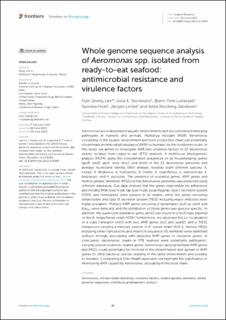| dc.description.abstract | Aeromonas are widespread in aquatic environments and are considered emerging pathogens in humans and animals. Multidrug resistant (MDR) Aeromonas circulating in the aquatic environment and food production chain can potentially disseminate antimicrobial resistance (AMR) to humans via the foodborne route. In this study, we aimed to investigate AMR and virulence factors of 22 Aeromonas strains isolated from ready-to-eat (RTE) seafood. A multilocus phylogenetic analysis (MLPA) using the concatenated sequences of six housekeeping genes (gyrB, rpoD, gyrA, recA, dnaJ, and dnaX) in the 22 Aeromonas genomes and average nucleotide identity (ANI) analysis revealed eight different species; A. caviae, A. dhakensis, A. hydrophila, A. media, A. rivipollensis, A. salmonicida, A. bestiarum, and A. piscicola. The presence of virulence genes, AMR genes and mobile genetic elements (MGEs) in the Aeromonas genomes was predicted using different databases. Our data showed that the genes responsible for adherence and motility (Msh type IV pili, tap type IV pili, polar flagella), type II secretion system (T2SS) and hemolysins were present in all strains, while the genes encoding enterotoxins and type VI secretion system (T6SS) including major effectors were highly prevalent. Multiple AMR genes encoding β-lactamases such as cphA and blaOXA were detected, and the distribution of those genes was species-specific. In addition, the quinolone resistance gene, qnrS2 was found in a IncQ type plasmid of the A. rivopollensis strain A539. Furthermore, we observed the co-localization of a class I integron (intl1) with two AMR genes (sul1 and aadA1), and a Tn521 transposon carrying a mercury operon in A. caviae strain SU4-2. Various MGEs including other transposons and insertion sequence (IS) elements were identified without strongly associating with detected AMR genes or virulence genes. In conclusion, Aeromonas strains in RTE seafood were potentially pathogenic, carrying several virulence-related genes. Aeromonas carrying multiple AMR genes and MGEs could potentially be involved in the dissemination and spread of AMR genes to other bacterial species residing in the same environment and possibly to humans. Considering a One-Health approach, we highlight the significance of monitoring AMR caused by Aeromonas circulating in the food chain. | en_US |
